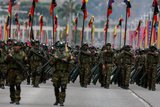Sperwer's time with the Canadian Forces draws to a close
After six tactical unmanned aerial vehicle (TUAV) flight rotations in Afghanistan, the Sperwer's mission came to an end on April 17, 2009.
Soldiers who had experienced its benefits gathered behind a barrier to witness the final launch.
With a roar of the engine, complemented by a nearby British flare show, they waited in anticipation for the CRACK! and ZOOM! of the little plane with the huge job, as it was sent flying into the dark Afghan sky. They watched the tiny blinking light as it gained altitude, changed direction and headed out on its final mission. The sound of cheers and sighs mixed in the air.
The members of TUAV flight, Roto 6 comprising a mix of Army and Air Force members working together, hailing from 400 Tactical Helicopter Squadron Borden, Ont., 4 Air Defence Regiment, Moncton, N.B., and other augmenting units. Pilots, artillery soldiers, analysts, maintainers, technicians, clerks and signals operators all had their own important role, but worked together to ensure that every flight would have the best chance at success.
It seemed that they really wanted to get the bang for the buck on this last rotation; about 30.5 per cent of the hours flown by all six rotations were clocked between August 2008 and April 2009. Overall, since the Sperwer's arrival in theatre, approximately 4, 270 hours were flown during more than 1300 total trips.
The significance of the Sperwer doesn't lie just in the numbers, but in the job it was able to do in the air. One of Sperwer's defining successes was its ability to fly during some occasions when no other craft could. The plane was designed so that it could handle the fiercest weather while continuing to provide imagery even during low cloud cover. Its infrared imaging capacity could deliver accurate intelligence any time of the day.
Captain Mark Horstead, a Sperwer Mission Commander on Roto 6, said he firmly believes that the Sperwer's presence in Afghanistan was beneficial. "A couple of IED [improvised explosive device] emplacement teams are no longer out there due to our efforts," he said, adding, "Hopefully, such successes and the value of having us buzz around have saved a few Canadian and Allied lives."
By Captain Jennifer Kellerman - Canadian Armed Forces
More from Uncrewed Vehicles
-
![What's next for the Pentagon after the Replicator programme?]()
What's next for the Pentagon after the Replicator programme?
Although the Replicator initiative has made several accomplishments, there are still multiple gaps to plug across the US Department of Defense (DoD) and its services.
-
![Cummings Aerospace showcases Hellhound loitering munition designed for US Army’s LASSO programme (video)]()
Cummings Aerospace showcases Hellhound loitering munition designed for US Army’s LASSO programme (video)
Cummings Aerospace presented its turbojet-powered Hellhound loitering munition at SOF Week 2025, offering a man-portable solution aligned with the US Army’s LASSO requirements.
-
![SOF Week 2025: PDW unveils attritable FPV drone for SOF operations at scale]()
SOF Week 2025: PDW unveils attritable FPV drone for SOF operations at scale
PDW has revealed its Attritable Multirotor First Person View drone at SOF Week 2025, offering special operations forces a low-cost, rapidly deployable platform for strike and ISR missions, inspired by battlefield lessons from Ukraine.
-
![SOF Week 2025: Teledyne FLIR white paper provides guidance on reusable loitering munitions]()
SOF Week 2025: Teledyne FLIR white paper provides guidance on reusable loitering munitions
Teledyne FLIR is highlighting the emerging requirements for 'recoverable and re-usable' loitering munitions across the contemporary operating environment during this week’s SOF Week conference in Tampa, Florida.
-
![SOF Week 2025: Kraken Technology group debuts K3 Scout USV in North America]()
SOF Week 2025: Kraken Technology group debuts K3 Scout USV in North America
High-performance maritime industry player Kraken Technology Group, based in the UK, has used the SOF Week conference in Tampa, Florida this week to debut its K3 Scout uncrewed surface vessel (USV) to the North American market.
-
![Palladyne AI and Red Cat to demonstrate capabilities for autonomous drone swarms to the US military]()
Palladyne AI and Red Cat to demonstrate capabilities for autonomous drone swarms to the US military
Red Cat and Palladyne AI recently conducted a cross-platform collaborative flight involving three diverse heterogeneous drones.

























